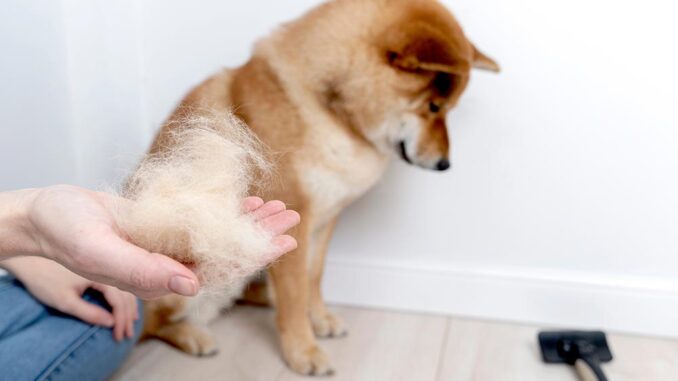
This article was updated on January 18th, 2024
As a veterinarian, I have come across numerous cases of hair loss in dogs. Knowing that the hair loss happened on the tail or back legs can help in determining the cause of the problem. In this article, I will explain the most likely causes, and what you can do at home. I’ll also discuss when it is necessary to seek veterinary attention.
Common reasons for dogs losing hair on their tail and back legs
Hair loss on your dog’s tail and hind legs is a symptom. There are a variety of possible causes ranging from parasites and allergies to infections and hormonal imbalances.
1. Fleas
One of the top causes of hair loss on a dog’s tail and hind legs is flea allergy dermatitis (FAD). FAD is an allergic reaction to flea saliva.
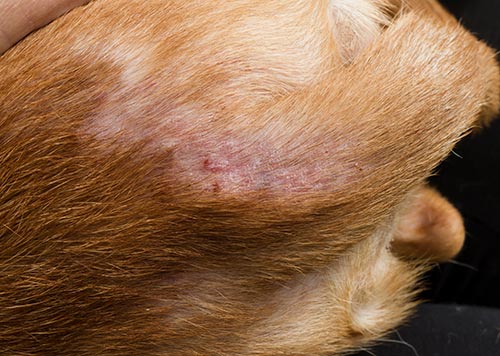
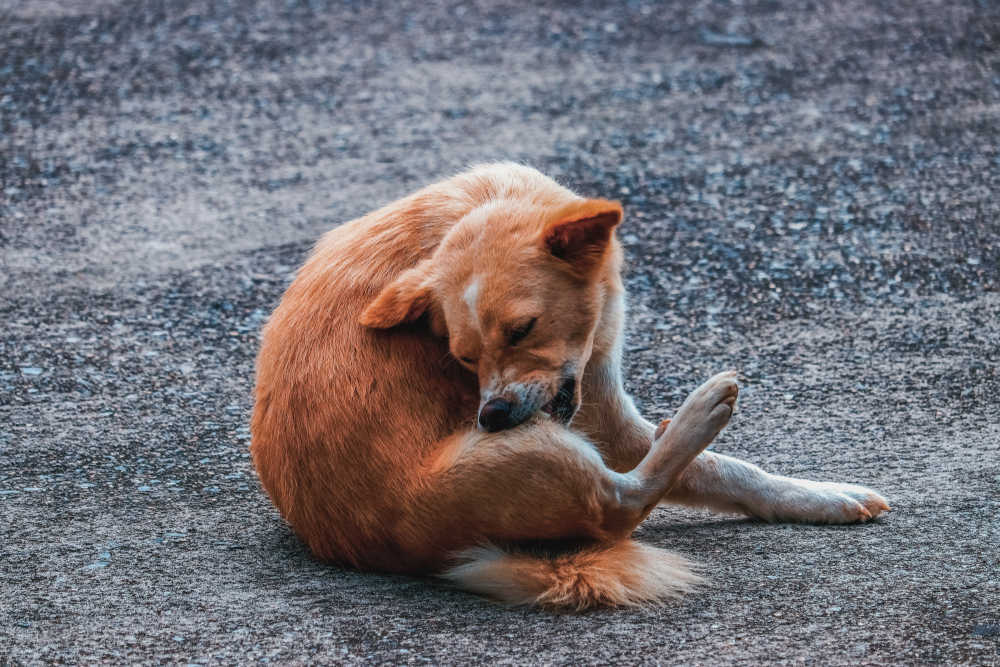
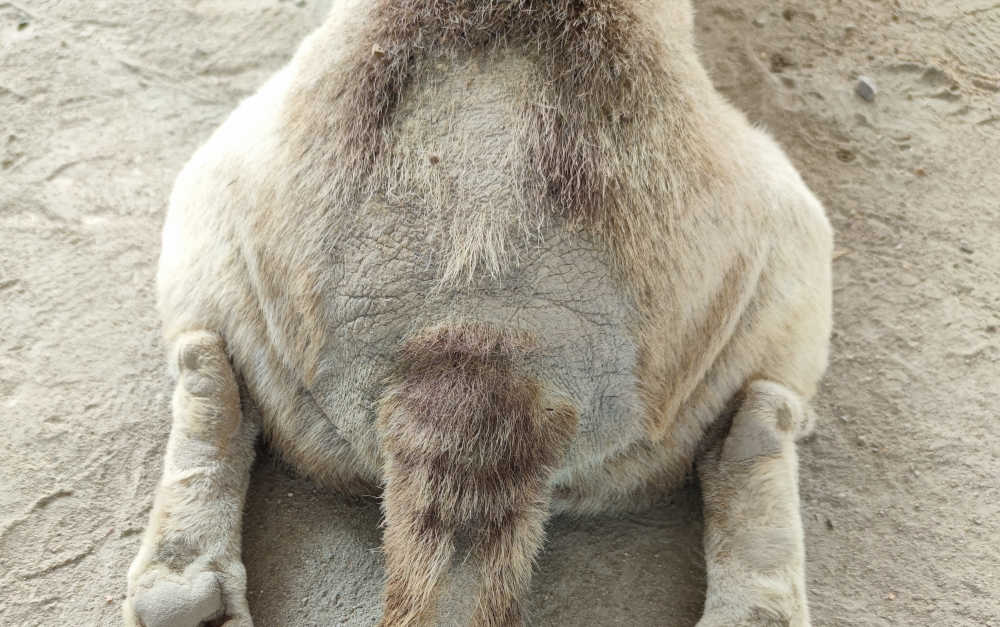
Symptoms include:
- Excessive chewing or scratching/rubbing
- Hair loss around the tail, neck, and hind legs
- Small, red flea bites
- Red irritated skin
- Crusts and scabs
- Flea dirt (poop) or fleas when you use a flea comb or part the hair (see this picture)
FAD usually clears up when you eliminate the pests. Ask your veterinarian for recommended flea treatments including shampoos and dips. If your dog’s skin irritation is severe, the doctor may prescribe topical antihistamines or anti-inflammatories.
Learn more about flea allergy dermatitis (FAD) & 5 easy ways to tell if your dog has fleas.
2. Mites and other parasites
In addition to fleas, mites are common causes of hair loss around dogs’ tails and hind legs. Two types of mites can cause a skin disease known as mange. Demodectic mites usually affect puppies, seniors, and dogs with weak immune systems while sarcoptic mites can impact any dog. Sarcoptic mange, also known as scabies, is contagious.
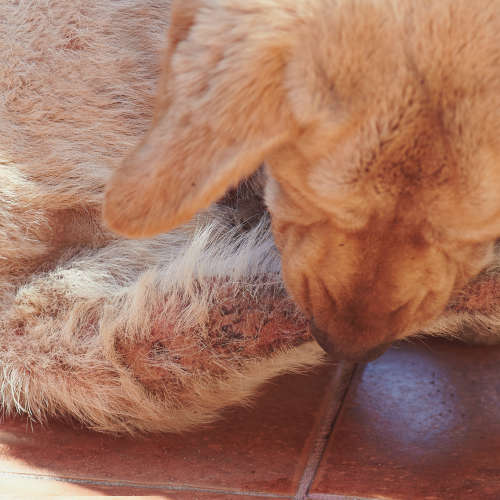
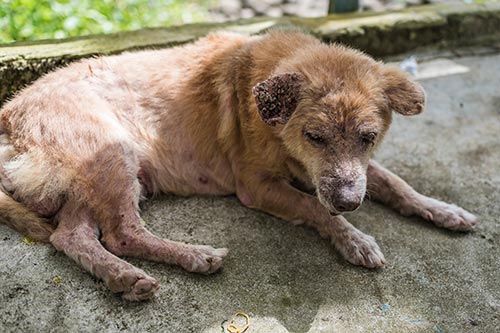
Signs of mange include:
- Local or generalized infection
- Itchy skin (can be uncontrollable with sarcoptic mange)
- The skin may be crusty, swollen, and red
- Hair loss in patches or generalized
- Skin pustules
- Skin rash
You can eliminate mites with medicated dips that contain amitraz or lime sulfur. If your dog contracts scabies, you should treat the environment to prevent reinfestation or disease spread.
Learn more about Mange in Dogs: Pictures & Treatments.
3. Allergies
Allergies are very common in dogs with an estimated 10-20% of dogs suffering from allergies. Dogs with allergies to food or environmental stimuli often suffer from skin irritation and itchiness. Over time, the irritation can lead to hair loss. Pictured below is a dog with hair loss & black spots on skin near the tail as a result of allergies:
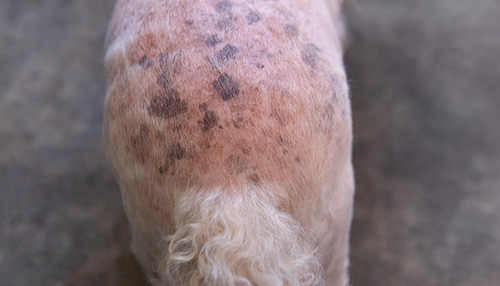
When allergies affect the skin, symptoms may include:
- Red, inflamed skin with itchiness
- Hair loss around the tail, legs, belly, and face
- Itchy skin, particularly around the ears and paws
- Recurring ear infections
- Poor hair coat
- Hives
Once allergies or sensitivities surface, they’re usually life-long. Early diagnosis and preventative measures are important and can help you manage the condition. If your pup has food sensitivities or allergies, try feeding a hypoallergenic diet with novel proteins. For other allergies, you may be able to limit exposure once you identify the allergen. If needed, your veterinarian may prescribe anti-allergenic medications.
Learn more about skin issues due to allergies.
4. Anal Gland Issues
As many as 15% of dogs suffer from issues with their anal glands. These dogs will often start chewing around their tail area or pulling out their hair. Anal glands are two small sacs that contain a fishy-smelling liquid that serves to lubricate the feces and mark territory.
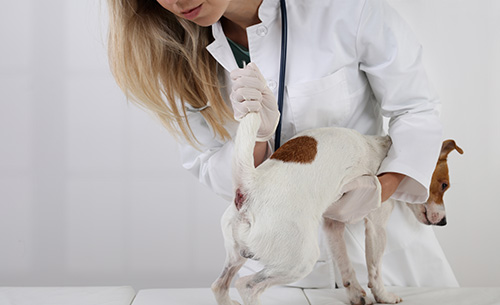
Your dog usually expresses the glands naturally when he poops. However, if your furbaby cannot evacuate the glands, they can become swollen, painful, and may become infected. Signs of anal gland impaction or infection include:
- Licking around the tail and anus
- Biting the tail and anus area and pulling out hair
- A strong, fishy odor coming from the hind end
- scooting (dragging his butt along the ground)
- Swelling around the anus
Clogged or impacted anal glands are painful and require veterinary attention. You may be able to apply warm compresses on the sacs, which are located on either side of the anus at approximately 7-8 o’clock and 4-5 o’clock.
Usually, the sacs will have to be manually expressed to evacuate the fluid. We strongly recommend you let your veterinarian express your dog’s glands rather than going to a groomer or attempting to do it yourself. Improper techniques can damage the sacs and ducts and cause more problems.
Find out the best ways to tell if your dog’s anal glands are full.
5. Stud tail
Dogs have a gland at the base of their tails. If the gland enlarges or becomes clogged or infected, secretions may accumulate and cause hair matting. Notice the focal bald patch near the base of the tail in the picture below:
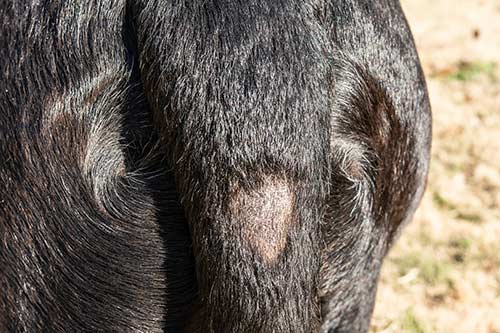
Sings of tail gland hyperplasia or infection include:
- A bald spot on top of the tail, near the base
- Matted hair
- Hair loss
- Painful, swollen tail
- Darkened/black skin
- Secondary infection with crusting, irritation, and itchiness
Stud tail is generally not serious, but the gland can become infected. If your dog has tail gland hyperplasia but no infection, your veterinarian may prescribe topical ointments and medicated shampoos to relieve the inflammation and irritation. When an infection is present, treatment will include topical or oral antibiotics.
6. Worms / Internal parasites
When dogs become infected with tapeworms, some segments occasionally exit the digestive tract and stick to the hair around the anus, as shown in the picture below:
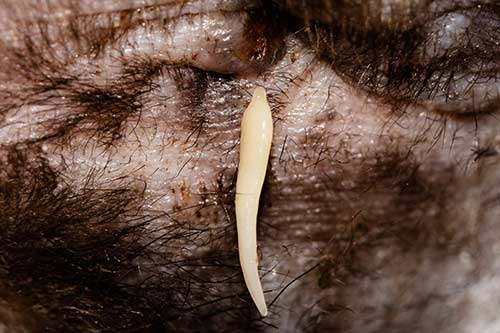
The proglottids irritate the anus and cause itching. Signs of tapeworm infestation include:
- Scooting
- Licking or biting around the anus
- Presence of tapeworm segments around the anus or on your dog’s poop
- Bald patches on or under the tail
Repetitive licking and biting around the anal area can lead to hair loss on your dog’s tail and hind legs. To confirm a tapeworm infestation, your veterinarian will request a fecal sample. The treatment of choice is oral or injectable praziquantel. Tapeworms are rarely harmful to dogs.
Learn more about worms & what they look like.
7. Tail pain
Sometimes, an injury to the tail or arthritis in the hindquarters can cause excessive grooming. If your dog has a broken tail or arthritis pain, he may lick and bite at the area and cause hair loss around the tail and hind legs.
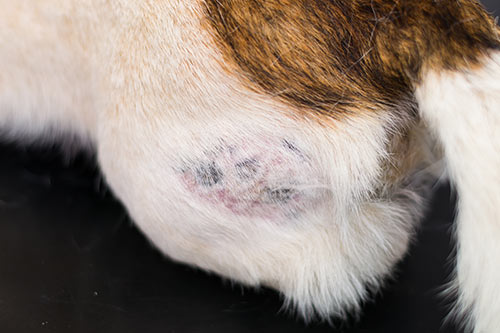
A physical examination and history will help your veterinarian diagnose the issue. Treatment will depend on the diagnosis but may include anti-inflammatory drugs and pain medication.
8. Hormone imbalance
Both hypothyroidism and Cushing’s disease in your dog can cause hair loss. When dogs suffer from hypothyroidism, their glands don’t produce enough thyroxine. With Cushing’s disease, a dog’s adrenal gland overproduces cortisol.
Symptoms of hypothyroidism include:
- Balding and hair loss
- Weight gain without an increase in appetite
- Dull hair coat
- Lethargy
- Skin darkening
- Increased susceptibility to skin infections
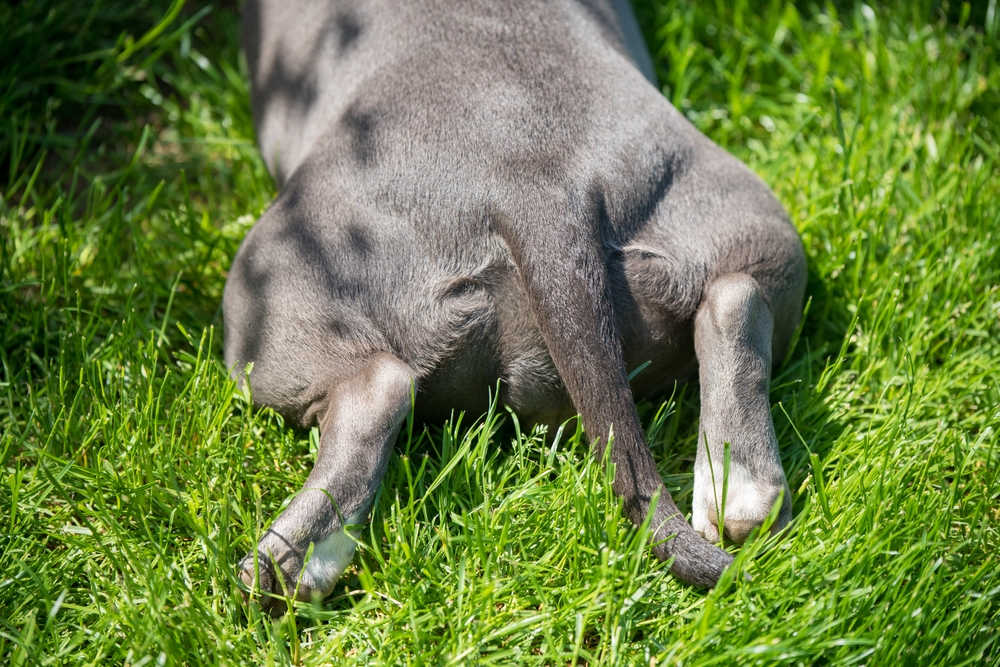
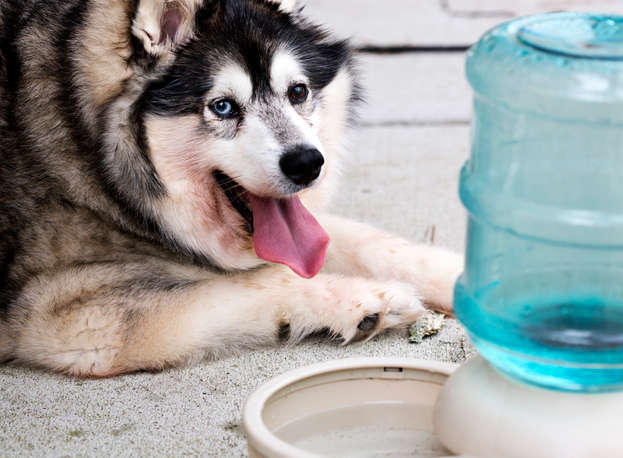
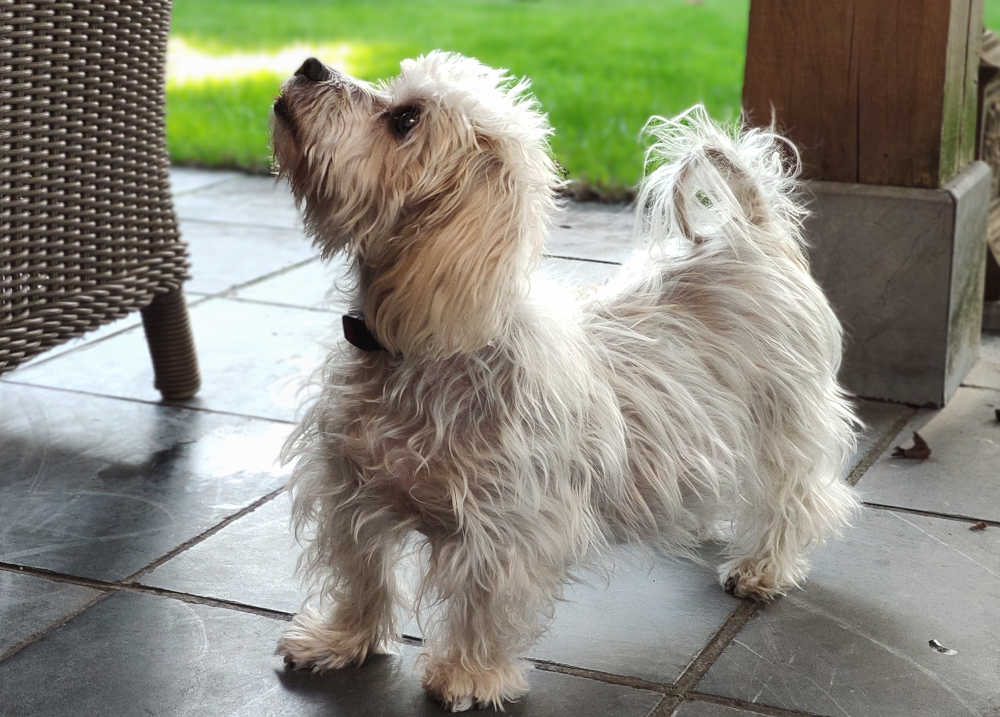
Symptoms of Cushing’s disease include:
- Symmetrical hair loss along the abdomen, back, back legs, and tail
- Potbelly appearance
- Thinning skin
- Increased appetite
- Increased drinking/urination
- Lethargy
Your veterinarian can diagnose a hormonal imbalance based on history, physical examination, and special blood tests. Both hypothyroidism and Cushing’s disease are lifelong conditions that will require ongoing management.
Learn more about Cushing’s Disease: Pictures & Treatments.
9. Stress or anxiety
If your dog feels stressed, he may obsessively lick or groom his tail and hindquarters to self-soothe. Some pups will also pull their hair out.
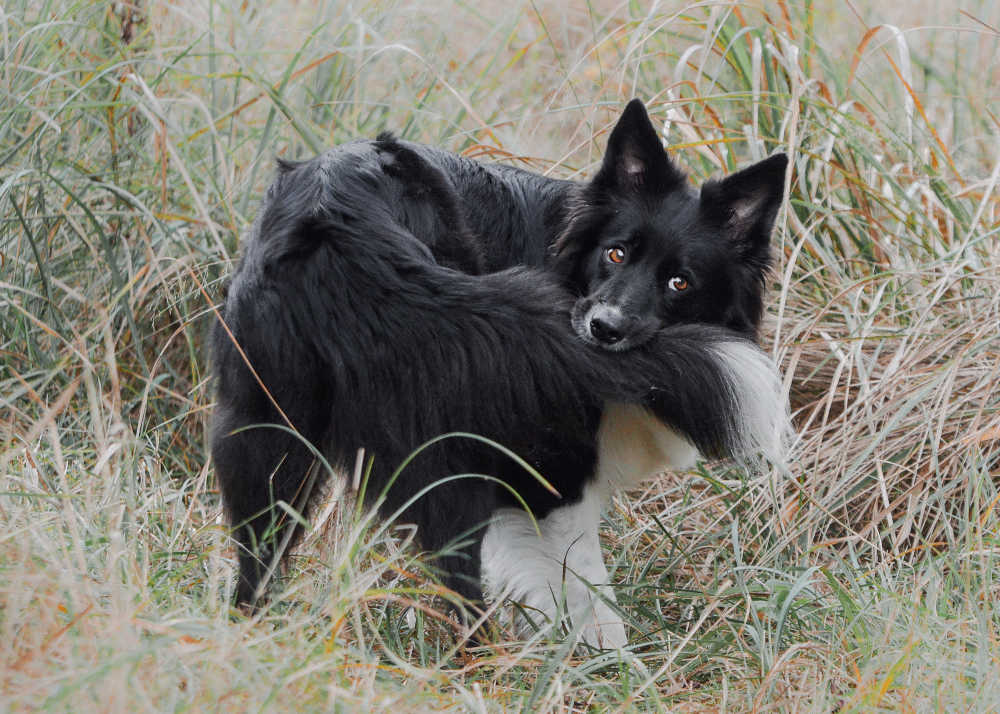
If your dog is licking and chewing himself, you may notice
- Saliva on the tail or hind legs
- Broken or damaged hair
- Rust-colored or brownish-red saliva stains on the fur
- Pacing
- Excessive panting
- Whining or whimpering
- Destroying things when you leave your furbaby home alone
- Hiding
The best way to manage stress is to provide your dog with a stable routine and a safe place such as a crate where he can feel secure.
General symptoms associated with hair loss on the tail and back legs
As noted above, there are specific signs for each cause of hair loss on your dog’s tail and legs. However, some symptoms are common across various conditions.
- Excessive biting, licking, or scratching of the affected area
- Swelling
- Dry, cracked, or scaly skin
- Red, irritated skin
- Foul, musty odor
- Blood or discharge
When should you seek veterinary assistance?
If you notice your dog losing hair around his tail and hind legs, ask yourself whether this is a part of his normal shedding pattern or something out of the ordinary. In the latter case, you should talk with your veterinarian about your observations to determine if you should schedule an appointment. Most causes of hair loss will require some treatment.
However, you should take your dog to the vet or schedule an appointment as soon as possible if
- There are bald patches
- You notice the skin has darker pigmentation
- There’s a foul odor associated with the hair loss
- Your dog’s appetite or thirst level change
- You notice depression or lethargy
Are there any home remedies or over-the-counter treatments I can try?
If your dog’s condition isn’t an emergency, you can try a few things to relieve his discomfort at home before your appointment.
- Prevent excess licking/grooming by putting an E-collar on your dog. This will minimize damage to his skin and hair until you can treat underlying conditions.
- Rub some unrefined coconut oil on bald patches of skin to ease inflammation and encourage hair growth.
- Supplement your dog’s diet with omega fatty acids and vitamin E to promote skin and coat health.
- Consider switching your dog’s diet to a well-balanced hypoallergenic formula that promotes healthy skin and hair.
Likely costs of various treatment options
The treatment for hair loss on the tail and hind legs varies depending on the diagnosis.
- For flea or mite infestations, the treatment is usually a medicated shampoo/dip or topical medications Cost of treatment is usually around $150 or less.
- The cost of treatment for anal gland disease varies depending on whether your dog needs manual expression, flushing, or treating an infection but will likely range between $20 and $150.
- The treatment for stud tail will usually be around $50 or less unless there’s a severe infection.
- The average cost f treatment for tapeworms in dogs is $300
- If your dog has arthritis, the cost of medicine may run $30-100 per month depending on the severity of the pain and deterioration.
- For hypothyroidism, levothyroxine is usually the replacement hormone of choice, and the cost depends on your dog’s size/weight. It is affordable.
- Medical treatment for Cushing’s usually ranges between $50 and $200 per month.
Frequently asked questions
What are the factors that may contribute to hair loss on the tail and back legs?
There are predisposing factors that can increase the likelihood that your dog will suffer from hair loss on his tail and back legs.
Genetics: Certain dog breeds are more likely to suffer from hair loss on their bodies. Some breeds with a predisposition for hair loss include:
- Chinese crested terrier
- Certain hairless breeds such as the Mexican hairless
- Poodles
- Whippets
- Beagles
- Boxers
- Boston terriers
Environment: If your dog suffers from sensitivities or allergies, his environment can trigger hair loss. Additionally, overly dry or moist air can affect your dog’s haircoat. Dry air may cause the hair to become more brittle and break off. A humid environment may contribute to skin infections.
Nutrition: Dogs need a well-balanced diet to ensure healthy hair. When certain nutrients like vitamin E, essential fatty acids, and essential minerals are insufficient, the hair may become brittle, dry, or dull. If deficiencies continue, the hair may fall out. The first place hair falls out is usually the tail because the follicles on the tail tend to produce one hair shaft at a time.
Would a vet be able to help over a video call?
If the cost of treatment is a consideration for you, a video call may be an affordable first step. The veterinarian can ask you questions about your dog’s symptoms and history. Additionally, you may be able to show your dog’s tail and hind or share a picture. Depending on visible signs and symptoms, the doctor may be able to recommend some things to try at home.
Unfortunately, several of the conditions require further testing to confirm a diagnosis. The doctor can’t conduct a hands-on physical over a video call, and this makes it challenging to develop the best possible treatment plan.
How long does it usually take for hair to regrow after treatment?
The time it takes for your dog’s hair to grow back varies depending on his breed, the season, and other factors. In some cases, hair will regrow in a month, but for others, it may take up to a year.
Is hair loss in dogs preventable?
You may not be able to prevent every cause of hair loss in your dog. However, use the following practices to reduce the likelihood that your pooch will experience problems:
- Buy your puppy from a reputable breeder
- Feed your dog a well-balanced diet that includes essential fatty acids and a balanced blend of vitamins and minerals
- Use flea and tick preventives that also protect against mites
- If your dog is diagnosed with a hormonal disorder, follow your vet’s treatment plan
Related posts:
Disclaimer: This website's content is not a substitute for veterinary care. Always consult with your veterinarian for healthcare decisions. Read More.



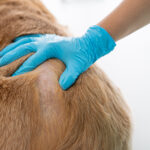
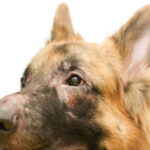
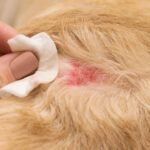
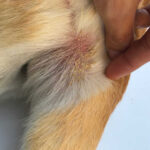
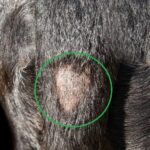

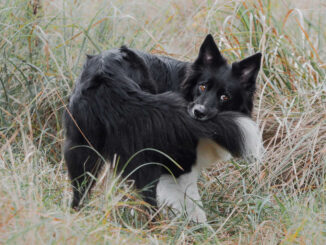
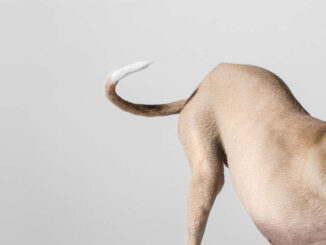
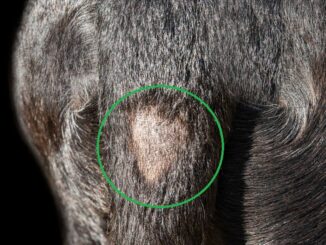
Be the first to comment